Fly fishing is widely considered a gentleman’s sport. In pursuing fish on the fly, we actively handicap ourselves to give our “opponents” a leg up. We cast tiny flies on flimsy tippets in the hopes of fooling educated trout. Our movements are slow and calculated; one false step could be a lost chance. Success, if measured in fish landed, can be hard to come by; but it is this self-inflicted difficulty that makes the pastime so enthralling.
Given the inherent challenge of fly fishing, I am often pleased if I manage to fool a few fish in a trip. However, there are some outings that prove so unimaginably successful that the “gentleman” is taken right out of the sport. Fish are caught by the dozens, each one more eager than the last to taste the cold steel of your hook. On these days, it seems you couldn’t possibly do anything wrong. The fish are happy, you’re happy – stupid happy. And perhaps that’s the only way the fishing can be described – stupid.
I’ve been lucky to experience a few of those days this year. Blue-lining in April. Stocked trout in May. Bedding smallmouth in June. Chubby-crazed Montana trout in July. White Mountains wilds, also in July. Alright, so maybe 2023 has been a pretty spectacular year of fishing for me. But none of these trips stack up to the out-of-this-world streamer fishing I had in Maine last weekend.
The trip began at 4:45 on one of the most popular trout and salmon pools in the state. 4:45 in the morning, that is. Thankfully my efforts made me the first on the water, but it wasn’t long before the tranquil silence of pre-dawn was pierced by fellow anglers clambering for their chance at a world-class Rangeley fish.

At 7:45, I landed my only trout of the morning, a slightly disappointing 12-incher. Certainly not the pre-spawn brute I hoped for, nor the crazed streamer frenzy I alluded to. Hang in there, though, because the story is only starting.
After that catch, it became glaringly obvious that nobody else was having any better luck than me. In my three hours of fishing, I hadn’t seen a single other fish caught, and reports from the prior day were equally glum. By 8:00, I was off the river. It was time to head to the real destination for the day.
Most of us suburbanites would consider the Rangeley region fairly remote. 1,000 year-round residents, few major roads, and an abundance of woods & water. Try traveling an hour north and 20 miles in on a dirt road to an unincorporated township with 0 year-round residents, no major roads, and – well I guess the abundance of woods & water remains the same. Rangeley quickly felt like Manhattan.
The trip in was accompanied by a few of the locals, namely white-tailed deer, a bald eagle, and a bull moose. With the foliage popping and the mountains emerging from the morning fog, it was about as perfect a September day as one could hope for.
The first stop was at a large pool in a relatively small river. Here, the rushing current slowed to an expansive deadwater, perhaps a relic of the logging days of yesteryear. Having had good luck at this spot historically, I was confident I might find the fish fast.
“Watch this,” I boldly proclaimed to my mom and grandfather, my travel companions and faithful supporters. I pulled back on the Higa’s S.O.S. attached to my tippet, forming an arc in my rod like a bow. After sending the nymph flying into a seam, it was a matter of seconds before I set the hook, soon landing the second trout of the trip. Like the first, this was no trophy, but a good omen of the fishing to come.
I continued plying the pool, now using a Wood Special on a sinking line. A respectable smallmouth followed the trout, then a hefty fallfish was fooled by the streamer. The fishing was good, but the best of it was still yet to come.
Craving some surface action, I worked my way upstream with a Chubby Chernobyl. Here the water was more like a small stream, the pockets lending themselves to short casts and fast presentations. Brookie after brookie sucked down the bug, averaging about 10 inches – much better than a typical small stream, but still nowhere near the caliber you might expect to find in late September. Adding a nymph dropper enticed some slightly larger fish, though it only added an inch-or-so to the average size.

Within an hour-or-so, I felt I’d worked the short section of river as thoroughly as I could. Seeing as those fish likely hadn’t seen a fly all year to make them wary, it isn’t far-fetched to say that I had fooled just about every hungry fish in the vicinity. Satisfied, I hiked a mile upstream to where the stream is first born, spilling over the dam on a sizable lake. It is here where the story gets really interesting.
With the crazy summer of rain Maine has had, the water was really ripping over the dam. The current flowed heavy through the center of the deep pool, but diminished to deadwater along the edges. My first cast was with the S.O.S. under an indicator, letting it naturally drift from the fast water into the slower outskirts. It took no more than five seconds for the bobber to plunge, and the first salmon of the trip immediately launched itself in the air. Like the brookies, the salmon wasn’t big – maybe 11 inches – but it fought plenty hard. As it came closer, the reason for the fish’s spunk became clear: like a scene out of National Geographic, a wolf pack of four-to-five pound fish eagerly tailed the salmon, waiting for it to tire before they pounced. Whether these beastly fish were bass or trout, I am still unsure; notwithstanding, it was a sight to behold.

In the blink of an eye, I had released the salmon (into a side channel where it could recover) and tied on a streamer. After pitching the fly back into the current, my rod instantly doubled over again. This time a smallmouth put on a display of acrobatics, though I cut the fight short in hopes of getting my fly back in the action. I gently cradled the bass in the water to unhook it, keeping my sights set on a much larger fish just a few feet away. Suddenly the larger fish disappeared from my vision. “Ow!” I yelped startlingly, though I struggled to comprehend what had caused the outburst. Returning my gaze to the bass I was unhooking, I was shocked to find the larger fish latched onto my thumb. The fish had bit me! Never in my life had I encountered such aggressive fish.
With each successive cast came another fish. When I landed that first salmon, I had achieved the “slam” for the river – a brook trout, smallmouth bass, fallfish, and landlocked salmon – though many more “slams” were achieved afterwards. Eventually I got bored of throwing the first streamer, a fly of my own design called the SPF40 (Sebago Perch Fly 40), so I tied on the meatiest pattern in my box, an articulated Sex Dungeon. And whaddayaknow, on the very first cast I hooked a skinny, 〜20-inch salmon. Despite the fly’s size, the fish were undeterred, crushing it with vigor. Many more salmon and smallies were caught, with countless more missed on short strikes to the streamer’s hook-less back half.
With the fishing this spectacular, it was nearly impossible to put the rod down. But after what felt like the most action-packed hour of my life, I managed to peel myself from the pool to check in on my mom and grandfather.
I found them at a rocky outcropping overlooking the lake. The early-autumn leaves were tinged with their festive colors, vibrant hues of red, yellow, and orange illuminated by the late-afternoon sun. A haze had settled over the valley, most likely wildfire smoke from the blazes still burning to our north. The serenity of the western Maine mountains is unparalleled.
With just a few minutes to spare before we packed the car to return to Rangeley, I scrambled to take a few final casts. Bushwhacking through dense spruce to reach the pool directly downstream of the dam pool, I encountered a rowboat chained to a riverside tree. It appeared I wasn’t the only one enjoying this remote fishery.
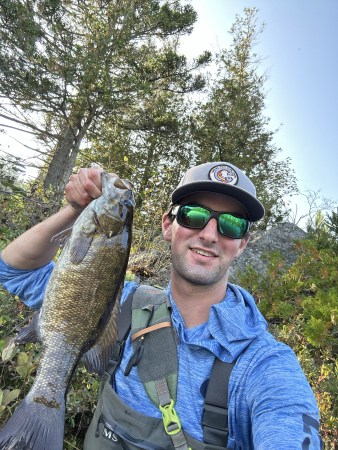
On my very first cast into the pool, my streamer was immediately intercepted by a three-plus-pound smallmouth. While it struggled to shake the hook from its maw, its buddies, a pack of four or five similarly-sized fish, grappled for a chance to steal the fly away. Unfortunately this bass managed to inexplicably pull hooks after two minutes of fighting, but thankfully it wasn’t the only fish I hooked in that pool. Every cast yielded another smallmouth, each one smaller than the last. It seemed when I hooked a fish of one size class, the others of similar size smartened up to my tactics. Still, the smallest fish I caught was around 12 inches, certainly not a dink by a fly angler’s standards.
With the final few moments of fishing time waning, I managed to land the nicest trout of the day. While it wasn’t a behemoth, orange-bellied, kyped-up male, I was happy to see that it was a very healthy female of about 14 inches.
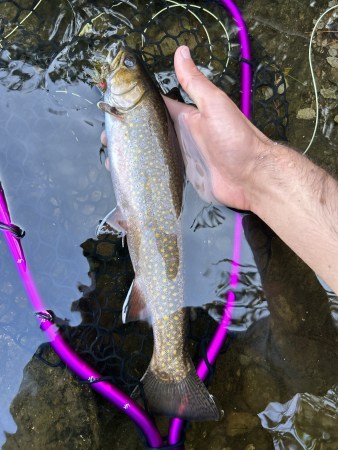
The return to Rangeley was highlighted by our ascent of 2,850-foot Quill Hill, which offered breathtaking views of the region’s mountains, accentuated by the golden glow from the setting sun. This was my first time up the hill, but for those in the area, I would certainly recommend the trip. The drive to the summit is quick and easy, and for those interested in the natural history, ecology, or geology of the area, several high-quality informational signs give an outstanding overview.

6:30 in the morning on October 1st is like a different world from 6:30 on September 30th at Maine’s most popular trout and salmon rivers. While anglers had mobbed the pool beside our cabin the day prior to make the most of the final hours of the regular season, there wasn’t a car for two miles now that the season had closed. Well, closed for this river anyway. By 11:00, I was knee-deep in a Rangeley-area river again, this one with special regulations that extends the season by a month.
With a deadline for our return home, I was given a strict one-hour time limit to fish. With the minutes ticking by, I fished fast and hard. In the first 15 minutes, I was rewarded with a hefty brook trout on the Dungeon, though it shook free when I went to net it. The next 35 minutes were largely devoid of fish, save for one trout that nipped at the tail of the streamer.
With a mere 10 minutes left on the clock and the streamer action slow as molasses, I knew I had to make a change if I wanted to put a fish in the net. In a vote of confidence, I allotted two of those ten minutes to switching out my leaders and re-rigging to my 2023 standby – a Chubby Chernobyl x Higa’s S.O.S. dry-dropper. Within two casts, the Chubby plunged and I netted the first fish of the morning, a small salmon. On the very next cast, I again hooked into a salmon, this one a bit chubbier than the last. With just one minute to spare, on my very last cast of the trip, a brook trout fell victim to the nymph, closing my season of Maine fishing on a high note.
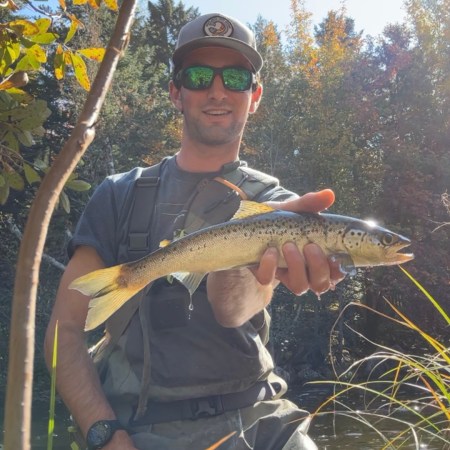
Maybe I’ll return to the Pine Tree State for some ice fishing come winter, but I’m content with my success fishing Maine waters through the spring, summer, and fall. I can proudly say I am making good use of my Maine lifetime license!


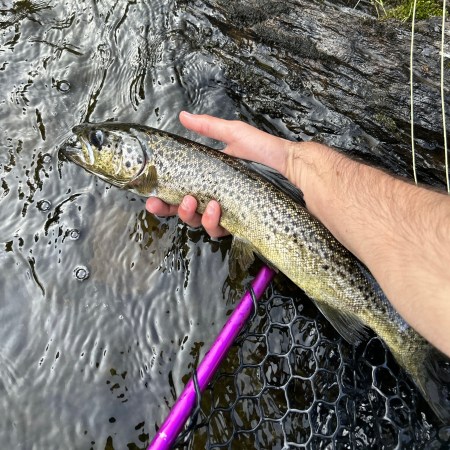
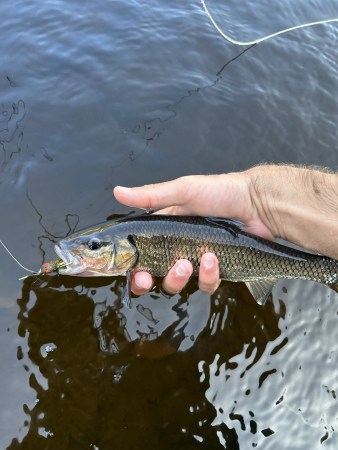

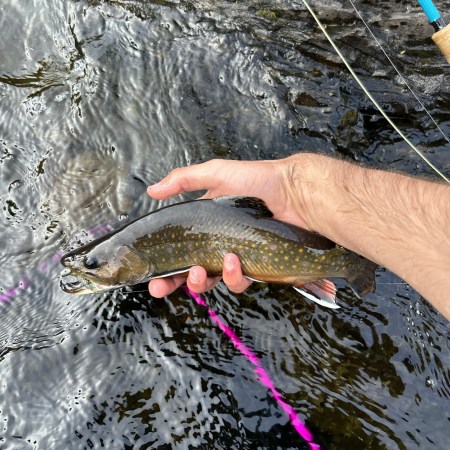
One thought on “Maine Streamer Season”